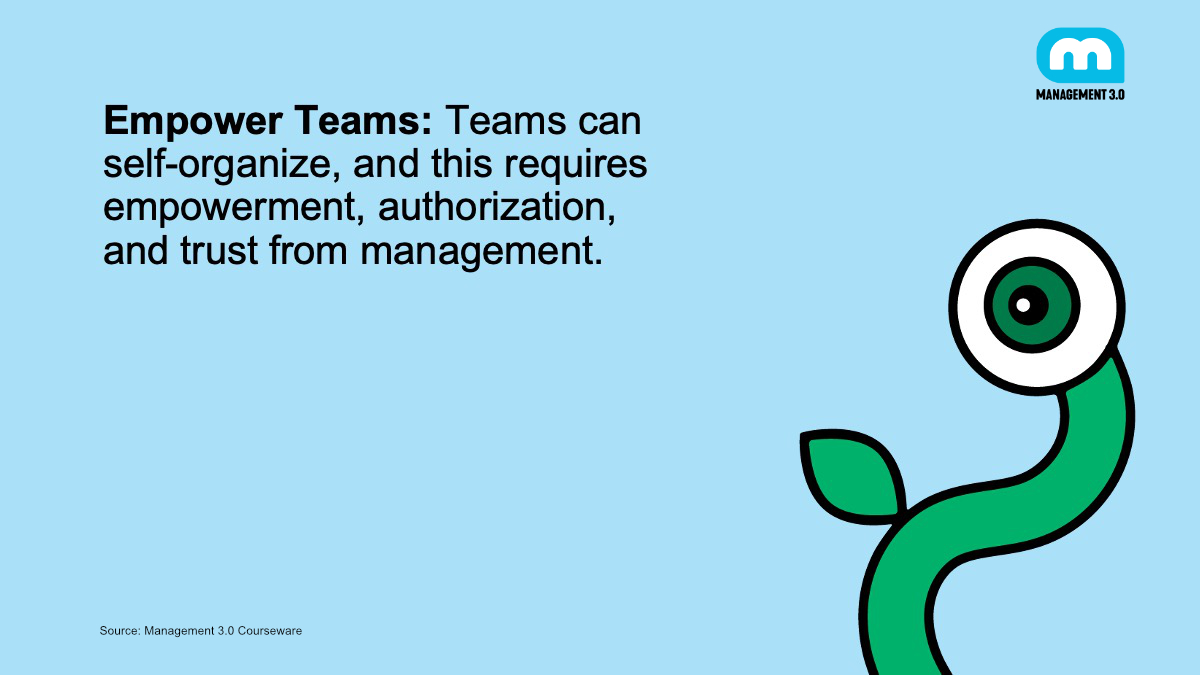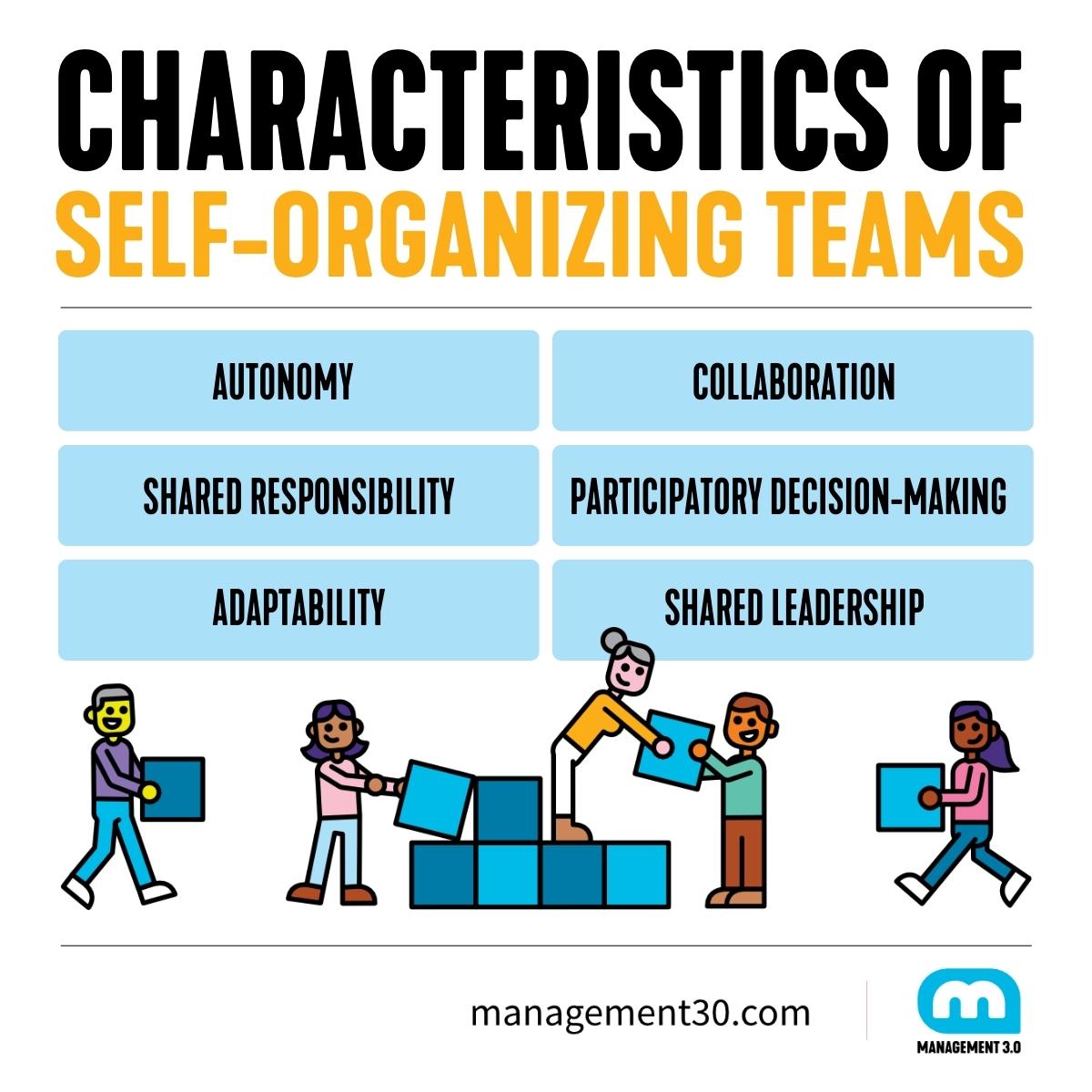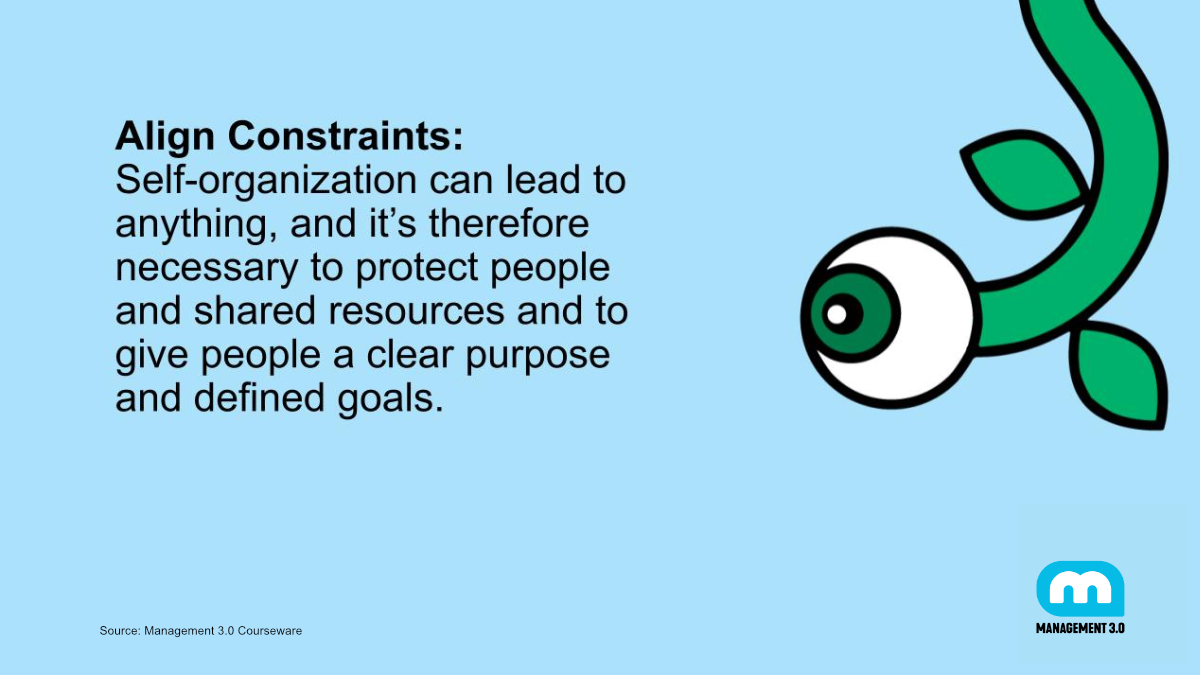In a world filled with rapid change and uncertainty, traditional approaches to teamwork and leadership often fall short. That is where the power of self-organizing teams comes into play. Imagine a dynamic group of individuals working together, not bound by rigid hierarchies, but driven by autonomy, creativity, and a shared sense of purpose. These teams have the ability to adapt swiftly, innovate fearlessly, and thrive amidst the chaos of our VUCA world. Discover why self-organizing teams are the secret ingredient to navigating uncharted territories, fostering resilience, and unlocking the full potential of individuals in this ever-evolving landscape – an article by Management 3.0 Facilitator Alexandre Vignado.
Self-organizing teams are based on trust, collaboration and the empowerment of individuals. These teams have the ability to make decisions, define their own processes and work autonomously, allowing each member to contribute their unique skills and experience.
In this article, I will explore self-organizing teams. Reviewing the principles underlying this approach, I highlight the importance of enabling leadership and establishing a culture of trust and transparency. The benefits that self-organizing teams can bring to organizations, such as greater motivation, engagement and adaptability in an environment of constant change will become clear. Examining the challenges and roadblocks that can arise when implementing self-organizing teams leads to practical insights on how to overcome them, ultimately guiding leaders who want to adopt this approach in their organizations and harness the full potential of self-organizing teams.
- What is self-organization?
- What is a self-organizing team in Scrum?
- Characteristics of self-organizing teams
- What are the challenges for self-organizing teams?
- How can you build great self-organizing teams?
By understanding the Management 3.0 philosophy and its relevance for self-organizing teams, organizations can transform the way they work, unlocking human potential and fostering a more productive, innovative and fulfilling work environment. Through this article, I hope to inspire and empower readers to explore new avenues in managing teams and driving sustainable success in an ever-changing world.
What is self-organization?
Self-organization is a concept that describes the capacity of a system or group of elements to organize itself spontaneously, without the need for a central authority or external control. It is the ability of the system to adapt, make decisions and regulate its own activities autonomously, based on the interactions and relationships between its components.
In the context of teams and organizations, self-organization implies allowing group members to take responsibility for managing their own activities and making relevant decisions to achieve common goals. Rather than being given detailed instructions by a leader or manager, individuals are empowered to define how to do their work, collaborate with colleagues, and pursue creative solutions.
Self-organization requires trust, collaboration, and effective communication among team members. It is based on the premise that people are able to make informed decisions and adapt to change more quickly and efficiently than when they are subject to tight supervision. By allowing individuals to voice their opinions and ideas, self-organization can also promote creativity, innovation, and engagement among team members.
It is worth noting that self-organization does not mean the absence of leadership, but rather an approach where leadership becomes more distributed, with leaders acting as facilitators, supporting the team and providing guidance when needed. It recognizes and values the collective intelligence and ability of individuals to self-manage their activities.

What is a self-organizing team in Scrum?
A self-organized Scrum team is a group of professionals who, by adopting Agile principles and following the Scrum framework, are able to manage their own activities and make decisions related to the work they do. These teams have the autonomy to organize themselves, define how to carry out their tasks, set goals and solve problems collaboratively.
Self-organization is one of the fundamental principles of Agile and Scrum, and it seeks to harness the collective potential of the team. Unlike traditional management models, in which tasks and decisions are imposed from the top down, self-organizing teams have the freedom to define the best approach to achieve established goals.
The self-organized teams in Scrum are multidisciplinary, composed of professionals with different skills and knowledge necessary for the development of the product or project. Within the team, members collaborate, share knowledge, and help each other to deliver value incrementally and iteratively.
These teams are responsible for planning and executing work in sprints, which are fixed time intervals during which work is completed and delivered. During sprint planning, the team decides which backlog items will be addressed and how they will be implemented. During the sprint, the team manages itself to achieve established goals and adapt to changes as they arise.
Self-organization is supported by collaboration, transparency and mutual accountability within the team. Each member is encouraged to take responsibility, share ideas, provide feedback and make decisions that benefit the work of the team as a whole.

Characteristics of self-organizing teams
Self-organizing teams have several distinct characteristics that set them apart from traditional team models:
- Autonomy: Self-organizing teams have the freedom and responsibility to manage their own activities and make decisions related to the work they do. They have the autonomy to define how to achieve the established objectives, select approaches and make decisions that benefit the project.
- Collaboration: Collaboration is an essential feature of self-organizing teams. Team members work together, share knowledge, experience and skills, and help each other to achieve common goals. Effective collaboration fosters a cooperative work environment and encourages creativity and innovation.
- Shared responsibility: In self-organizing teams, responsibility is distributed among team members. Each member is encouraged to take responsibility for different aspects of the work and actively contribute to the overall success of the team. This promotes individuals’ sense of belonging and intrinsic motivation.
- Participatory decision-making: Self-organizing teams value participatory decision-making. Rather than relying on a central authority to make all decisions, team members are involved in the decision-making process. This allows for a greater diversity of perspectives and expertise, resulting in more informed decisions and better solutions.
- Adaptability: Self-organizing teams are highly adaptable. They have the ability to respond quickly to changes in the environment or project requirements. Rather than relying on outside instructions, the team is able to adjust, redefine priorities and look for workarounds when necessary.
- Shared leadership: In self-organizing teams, leadership is not restricted to a single person. Instead, leadership is distributed among team members. Each member has the opportunity to lead in different situations, contributing their skills and experience to the team’s success. Shared leadership fosters an environment of trust and empowerment.

These characteristics help self-organizing teams to be more agile, adaptable, innovative and engaged. They allow team members to be protagonists of their work, promoting a collaborative and stimulating work environment.
What are the challenges for self-organizing teams?
Self-organizing teams are a crucial component of many modern organizations, especially those that embrace Agile methodologies.
However, while these teams can offer many benefits in terms of efficiency and innovation, they also face a number of challenges.
While self-organizing teams have autonomy, this autonomy must exist within clearly defined boundaries. A lack of clear boundaries can lead to confusion, misalignment and decreased effectiveness.
Self-organization requires a high level of responsibility, both individually and collectively. This can be challenging as it requires all team members to be fully committed to their roles and the team’s goals.
In the Management 3.0 philosophy, decision-making is decentralized, which can lead to challenges. Without a traditional leader to make decisions, there can be conflicts, indecisions or delays. Teams need to develop effective strategies for making joint decisions.
As Peter Senge, an organizational philosopher, observes, self-organizing teams require a mindset geared towards continuous learning and development. This can be challenging as not all team members may be prepared or willing to adapt to this culture.
Conflicts are inevitable in any team, but in self-organizing teams without a clear hierarchy, it can be especially challenging to manage. Teams must be able to resolve conflicts effectively and fairly without undermining the group’s dynamics or results.
Finally, it is essential to remember that self-organization is not a goal in itself, but a means to greater effectiveness and innovation. The ultimate goal must always be value creation, and self-organizing teams are just one of the tools that can help organizations achieve that goal.

How can you build great self-organizing teams?
Building great self-organizing teams is an exciting and rewarding challenge. As organizations look to drive agility and innovation, adopting this team model becomes increasingly relevant. However, it is important to be aware of the essential principles and practices for building successful self-organizing teams.
Foster self-organizing teams by establishing trust
First, it is essential to establish a culture of trust and transparency. Mutual trust is the foundation on which self-organizing teams develop. Team members must feel safe expressing their opinions, sharing ideas and taking risks. Transparency in information, goals and work processes are essential for alignment and effective collaboration.
You trust who you know, and a practice that helps you to get to know each other better is Personal Maps. Each team member could create their own Personal Map that highlights their skills, experiences, and personal aspirations. By sharing these maps, team members gain insights into each other’s strengths and interests, fostering collaboration, and self-organization based on individual capabilities.
Build self-organized teams by investing in skills development
It is also necessary to invest in developing the skills of team members. This includes providing adequate training, supporting professional growth, and fostering a culture of continuous learning. Skills such as effective communication, collaboration, problem solving and decision making are critical to the success of self-organizing teams.
The Team Competency Matrix helps to visualize and assess the skills and competencies within the team. By mapping team members’ skills on a matrix, the team can identify areas where expertise may be lacking or over-represented. This practice encourages self-organization by allowing team members to take ownership of their own skills development and promote cross-functional collaboration.
Promote self-organization by defining clear roles
Clearly defining roles and responsibilities is another crucial step in building self-organizing teams. Each member must understand their individual and collective responsibilities, as well as the interdependence between members. This contributes to a cohesive workplace which promotes effective collaboration.
Delegation Poker encourages team members and managers to have open discussions about the delegation of tasks and decision-making authority. It helps to define levels of empowerment and clarify who has the responsibility for different areas. By playing Delegation Poker, the team can establish a common understanding of delegation and distribute decision-making power effectively.

Build up for self-organization by creating an environment for autonomy
Create an empowered environment that is conducive to self-organization. This involves providing enough autonomy for team members to make decisions related to their work, but also setting clear boundaries and guidelines to ensure the team is aligned with organizational goals. Facilitative leadership and ongoing support are needed to nurture and sustain self-organization.
Internal Crowdfunding is a practice in which team members have the opportunity to suggest and pitch their ideas or projects to their colleagues. Each team member is given a certain amount of virtual currency or tokens they can invest in for the ideas they find most valuable or promising. This practice encourages self-organization by empowering team members to take ownership of their ideas, collaborate with others, and secure support for their initiatives. It promotes a culture of innovation, engagement, and self-directed action within the team.
Create self-organizing teams by fostering continuous improvement
It is key to foster a mindset of continuous learning and improvement. Self-organizing teams must have the freedom to experiment, fail, learn, and adjust their approaches. Periodic reflection on the team’s performance and identification of opportunities for improvement are essential to maintaining a culture of adaptation and growth.
A great way to do that is by using a Celebration Grid, for example in your retrospective. Make it visible what went well, what did not, and moreover, what you have learned. The Celebration Grid serves as a visual representation of collective accomplishments. It encourages team members to collaborate, support one another, and celebrate achievements as a unified team.

Self-organize to thrive
Building great self-organizing teams takes time, effort, and commitment.
However, the benefits of highly engaged, innovative and agile teams are immeasurable. By embracing the principles of self-organization and investing in the right resources, organizations can create an environment conducive to the success of self-organizing teams, driving growth and excellence in projects and organizational goals.
Build a solid leadership foundation in a VUCA world. Discover self-organizing teams, key principles, and practical tools for performance, collaboration, empowerment, and change management during a Management 3.0 Foundation Workshop:

